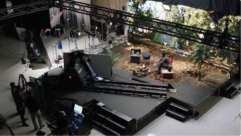Big Developments for Big Screen Venues
May 29, 2014 9:49 AM, By David Keene
The Giant Screen Cinema Association’s (GSCA) Film Expo 2014, that took place March 24-25 at the IMAX Theater in the Bullock State History Museum in Austin, Texas, was a great place to see the latest trends in large venue technology—in this case, through the prism of what is primarily an “education” market. The combination led to some very interesting discussion of ways to leverage new technologies for new applications.
Most of the attendees at the expo were IMAX operators, museums, and schools with strong educational movie programming, and they were able to screen films to book into their venues—the typical fare of nature documentaries and space and science films, etc. But the second day of the Film Expo 2014 brought some surprises and some very interesting ideas on how to more fully use the wonderful large-screen venues. This came mainly from presentations from some of the top execs and technical crew at Electrosonic, the company behind some of the world’s most sophisticated AV, control room, and cinema design/installations.
Martin Howe, in charge of Giant Screen Business Development at Electrosonic, together with Chris Conte, who heads up the entertainment division of Electrosonic, presented its technical session on “a wide range of timely topics and programming opportunities that digital technologies provide for giant screen theaters,” including “examples of alternative content, to demonstrate the flexibility to seamlessly integrate a range of media sources to help operators fully utilize their theaters.”
Howe and Conte kicked off the presentation with a beautiful demo of high frame rate (HFR). The demo used the same rig that was used throughout the two-day event to show all of the digital movies: two synced Christie DLP 4K projectors, 35K lumens each, contrast of 2100:1 full field, both with live inputs, and IMB (a Vista Spyder was used as a content input controller). And while I had seen such HFR demos at tradeshows like NAB, it was nice to see it in the field. The 48fps vs. 24fps A/B demos showed narrow to wider shutter angle configurations and how motion artifacts were eliminated with the HFR.
Howe and Conte stressed that going forward “giant screen” really means 4K. And to bring the point home, Conte introduced a beautiful aerial photography sequence shot in 4K digital by the same production crew in New Zealand that shot much of the Lord of the Rings and Hobbit movies. Conte explained that they shoot for a target brightness on screen of 14fL for 2D and 6fL for 3D. His demos showed that when done right, on both sides of the camera, and in exhibition, digital can rival 1570.
Probably the most interesting part of the Electrosonic presentation was the section devoted to alternative content for theaters. Here we get beyond the feature movies, mostly educational movies that populate IMAX and other museum screens. Alternative content can be Internet content, from companies like Gigipan.com and 360vr.com; it can be gaming content; presentation type of content from something as simple as PowerPoint or in more sophisticated configurations using a Vista Spyder for input; or from a 2D or 3D live camera. The most intriguing demo at the Electrosonic presentation was of alternative entertainment content from the satellite-based content providers. Howe and Conte showed clips from stunning productions that bring live concert, opera, or theatrical performances to the huge screen. Examples shown were:
MicroSpace, which brought the Bolshoi Ballet’s The Nutcracker SpectiCast, for the ballet Moulin Rouge; for the theater production of Caesar and Cleopatra; and concerts from Pat Metheny More2Screen, which brought the British Museum’s Pompeii Live movie and a Peter Gabriel concert.
If you have not seen a production like one of the above, in 4K, high lumen, huge screen, and with Dolby audio, you need to see what happens when you combine the best of large screen, IMAG, 4K, HFR, and full surround audio. This experience points not to just a very interesting use of what are normally educational venues but the future of video and audio in all venues.








